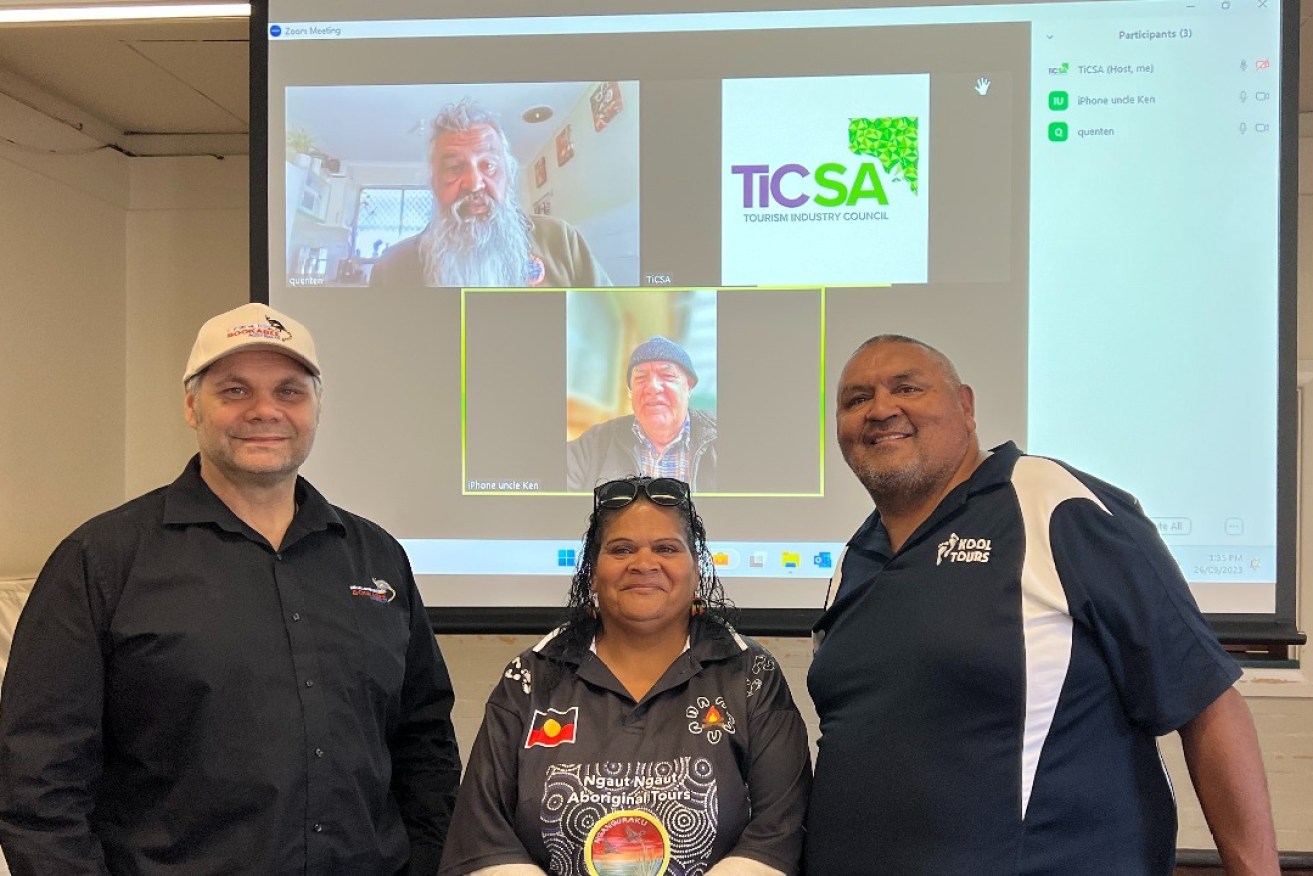SA tourism move to drive Aboriginal ‘cultural immersion’ experiences
The Tourism Industry Council of South Australia has created a professional association in support of Aboriginal tourism products and experiences across the state – a move that one operator says is long overdue.

The interim board of the Aboriginal Tourism Operators Council: In person, left to right, Haydyn Bromley from Bookabee Tours Australia, Ivy Campbell from Ngaut Ngaut Aboriginal Tours, Mark Koolmatrie from Kool Tours. On screen, Quenten Agius from Aboriginal Cultural Tours and Ken Jones from Bush Adventures.
Based on the success of the 20-year-old Western Australian model, the South Australian Aboriginal Tourism Operators Council (SAATOC) will drive the development of authentic Aboriginal-owned tourism businesses to realise the cultural and economic potential of the industry in SA.
Supported by funding from the South Australian Tourism Commission, the council will be led by chair and executive director of Bookabee Tours Australia, Haydyn Bromley.
The interim board –which will be in place until SAATOC is incorporated – was created during a workshop with eligible businesses.
“This is a vital step in maturing the tourism industry around the delivery of genuine Aboriginal cultural immersion experiences and tour product for the broader cultural tourism-seeking market,” Bromley said.
TiCSA CEO Shaun de Bruyn said “an association led by diverse and experienced Aboriginal tourism operators represents an exciting future for the growth of Aboriginal cultural experiences”.
One such tour operator is interim board member and owner of the award-winning Aboriginal Cultural Tours, Quenten Agius.
Agius has worked in the field for 20 years and has seen Aboriginal tourism operators go without support since even before then, saying “it’s about bloody time” for investment in the industry.
“Interest in Indigenous tourism in the past from our state and local government and regional development never really happened,” he said.
“It’s also because of what the nation, the people are starting to look at this Voice issue and how can the state move with the times with the other states.”
The Narungga and Ngadjuri man says Australia’s “starting to come of age” and that Aboriginal tourism needs support to meet the demands of the public’s interest in Indigenous culture, including being “international-ready”.
“You can say you’ve got Tandanya, an icon that people can actually go and visit, but is that a personal one-on-one with people out on the Country and developing a relationship, seeing the Country through the eyes of the actual true, authentic Indigenous operator?” he said.
Tandanya has been closed since at least Naidoc Week in July due to staffing issues and the cost of upkeep of its old building.
The tour guide also noted the importance of the next generation supporting the industry.
“There’s tour operators that operate today but hardly any of them are online,” Agius said.
“We need a lot of mentor programs running with the operators.
“The Aboriginal people themselves need to look at the Indigenous operators that are already working and running successful businesses in their Country and start working with them to value-add to help them put infrastructure and to move forward.”
The authenticity of Indigenous tourism experiences is also an important aspect, with Agius explaining that a government term like “site” doesn’t translate.
“In my eyes, growing up with my old people, that’s a cultural living area,” he said.
“Without that authentic experience, you’re not going to really grasp the experience of how Aboriginal people interact with their surroundings and how culturally their surroundings mean a lot to them.
“You walk into the Fleurieu Peninsula or the Barossa Valley and the aspect of anything to do with Indigenous [culture], they really look at paintings and sell paintings from other people’s Country and not recognising the Indigenous people of the area.
“A lot of businesses fail in that. They’d sooner go and deal with an Aboriginal group where they can just sign them up and the Aboriginal group don’t talk to the traditional owners of that area, therefore there is lack of communication and then that brings in disharmony because the people themselves who live in the area haven’t had the opportunity like these people have.”
Agius said the board is just beginning “a long journey” and “process of learning”.
“Not targeting people, it’s about putting a process in place so that, when it comes to dealing with Indigenous tourism, the state has a representative body that they can talk to, that will give the view of the operators,” he said.
“We’ve got to learn to crawl, before we can walk, before we can run.”




